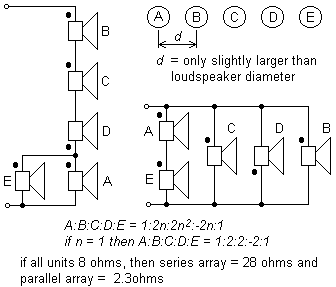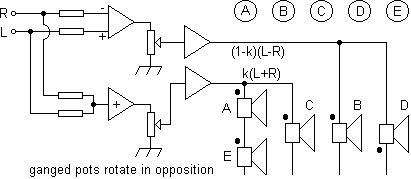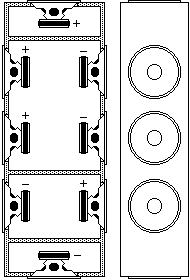Bessel arrays
Loudspeaker systems that use relatively large numbers of identical drive units tend to create a tight beam of sound and frequency 'holes' can occur. A Bessel array can result in even distribution. A proprietary system patented by Philips, lending itself to use with arrays of speakers and microphones, gives a near-spherical radiation pattern with as few as five transducers. Planes can be created using the same technique.
Simple Bessel series with five identical drive units satisfying the power distribution function ratio of A:B:C:D:E = 1:2:2:-2:1. Note polarities, indicated by bullets, and distance d being only slightly larger than loudspeaker diameter.

A Bessel series with seven weighting factors (function ratio of A:B:C:D:E:F:G = 1:2:2:0:-2:2:1) needs only six drive units because D = 0.

Nine drive units will have a function ratio of A:B:C:D:E:F:G:H:I = 1:2:2:0:-2:0:2:-2:1, thus two may be omitted.
A stereo layout does not require two banks.

Arrangement to obtain continuously variable base width setting. k = 0 gives superstereo, k = 0-0.5 expanded stereo, k = 0.5 normal stereo, k = 1 mono.

To reduce the cancellation effects, in expanded/superstereo, of low omni-directional frequencies contained in both channels, an input for bass reinforcement can be derived by combining LF left and right signals before the mixer.
Identical arrays placed side by side give a particularly horizontal radiation pattern (cinemas, theatres). Note how some senses are shown inverted compared to quoted ratio (ringed) showing variance in published data.

A spherical radiation pattern requires identical rows and columns.

A seven-by-seven Bessel array, suited to architectural (eg; ceiling) uses (some of the polarities given by the Philips paper can be questioned, as in the array below). Suggestions for wiring this array for stereo are invited.

Twenty-five units can be combined in a fairly simple manner, the weightings being rearranged to reduce the number of drive units to eleven.


